English Pork Pie: Important Temps and Recipe
In Great Expectations, Charles Dickens’ coming-of-age novel of poverty and charity, the narrator and main character, Pip, steals food from his aunts for an escaped convict. Pip describes his pilfered loot thus:
“I stole some bread, some rind of cheese, about half a jar of mincemeat…some brandy from a stone bottle…a meat bone on it, and a beautiful round compact pork pie. I was nearly going away without the
pie, but was tempted to mount upon a shelf, to look what it was that was put away so carefully in a covered earthenware dish in a corner, and I found it was the pie, and I took it…”—Charles Dickens
That got us thinking about beautiful round compact pork pies!—Which aren’t really pies but are in essence, pâté en croute—sausage in a shell—a crust-coasted meatloaf.
The traditional English meat pie is made by surrounding a column of seasoned meat with a sticky short-dough to form a free-standing “pie” that is at once humble and awe-inspiring. Golden crust surrounds savory meat in a pillar that bridges the pastry and butcher’s arts. It can be served with or without gravy. It’s kind of a culinary triumph, but well within your grasp and absolutely perfect for a
But a successful pork pie depends heavily on controlling your temperatures. So grab your ChefAlarm®and Thermapen® Mk4 and learn how to make a beautiful meat pie that you won’t have to steal to treat your family or friends this Christmas!
Contents
Pork pie basics
English pork pies go back to at least the 14thcentury, if not much further.
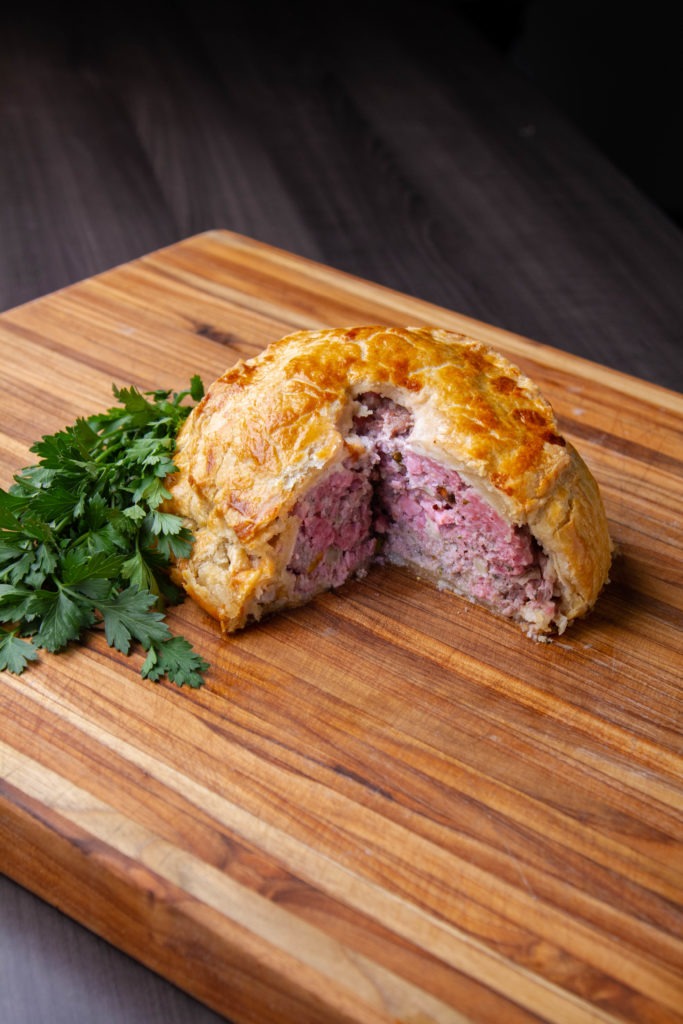
Their ancestors were made with dense hot-water dough that acted as a container for the meat, helping to protect and preserve it. The crust was often actually discarded after eating the meaty filling. As with all cuisines, regional variations do exist, each with their own seasonings, shape, and mode of eating. They can be eaten cold, though they are equally likely to be enjoyed piping hot (there seems to be some regional preference in this regard). In some regions, they are baked in a cylindrical form to keep their shape, but in
But how do you make it? First, you make sausage.
As you may have read in our post on homemade bratwursts, the steps in making sausage can be boiled down to the following:
- Chill
- Grind & season
- Mix
- Stuff
- Cook
We’ll obviously be omitting the ‘stuff’ step, but the rest holds true. And every one of the steps is important to achieve the proper emulsion that will ensure out filling comes out firm and juicy, not crumbled and swimming in a pool of its own fat.
By chilling both the meat and our grinding apparatus before grinding, we help the emulsion to form without the fat melting out. If the fat gets warm and greasy, it will not mix in properly.
Mixing the meat well allows for the formation of myosin—a protein complex that is analogous to the gluten strands in bread dough. The mixing allows the strands to form a net that will hold onto moisture and rendered fat while the pork pie cooks.
Key temps
Emulsion temps
Chill your meat well right before grinding it, and store the grinder in the freezer for at least a half hour before grinding. Don’t let anything get above 40°F (4°C). Keep your Thermapen onhand to check temps as you go along, as the friction of mixing will tend to warm up the mixture. Use cold ingredient wherever possible in the ‘sausage’ making, and don’t hesitate to put the mixture back in the refrigerator halfway through if the temperature starts to creep above 40°F (4°C).
Crust crisping
You can always tell how you did with your crust after the meal. If your guests leave behind empty shells of crust with the filling gone, you likely didn’t get the crust just right. What you want are clean plates where only the crumbs of the crust remain! To accomplish this, we need to keep the chewiness down and the flakiness up.
We can keep the chew-factor low by keeping everything cold while making the dough. Cut up the butter and lard into chunks and chill them well before starting. Go ahead and measure your butter or lard with your Thermapen. It should be below 40°F (4°C) when you add it to the flour. You might even chill your flour for an hour or more before you begin. Keeping the ingredients cold will cut down on the formation of gluten, which acts to toughen the crust and make it chewier. To keep the gluten down, it is also important to not over mix the dough.
To ensure flakiness, you need to use temperature sense. When you cook the pie, start it in a very hot oven, 425°F (218°C), to flash-evaporate the water in the butter and in the crust. This will create separation between the layers, yielding a crisp, flaky crust. If you cook the pie at a lower initial oven temperature, the water won’t evaporate as quickly, letting the starches gel and the proteins coagulate into a solid, chewy mass.
Once the crust’s oven-spring is complete (after 10-15minutes), turn down the oven and cook the pie at a lower temperature (325°F [160°C]) the rest of the way.
Meat finishing
To cook the meat the rest of the way means we need to cook it safely, but not overcook it. Insert the oven-safe probe of a ChefAlarm into the center of the pie and set the high alarm for 150°F (66°C). When the ChefAlarm sounds, verify the temperature with your Thermapen. Cooking beyond this temperature will cause all the liquid in the pie to be expelled from the meat, leaving it dry and crumbly. You want your holiday pie to be both firm and juicy!
English Pork Pie Recipe
Recipe based on one by Michael Ruhlman and Brian Polcyn
Ingredients
For the dough
- 8 oz (16 Tbsp) cold unsalted butter, diced
- 8 oz cold lard, diced
- 1 lb all-purpose flour
- 1 large egg
- Water, as needed
For the meat filling
- ½ C finely chopped onion
- ½ C finely diced, peeled cooking apple such as Granny Smith
- 1 Tbsp chopped garlic
- 1 Tbsp unsalted butter
- 1 ½ lb boneless pork shoulder, diced (or 1 ½ lb ground pork)
- 1 Tbsp kosher salt
- 1tsp black pepper
- ¼ tsp ground allspice
- 1 tsp fresh thyme leaves
- ½ C cold chicken stock
- 1 C diced smoked ham (optional)
- ¼ C roasted pistachios (optional)
For the eggwash
- 1 large egg yolk
- 1 egg
- 1 Tbsp whole milk
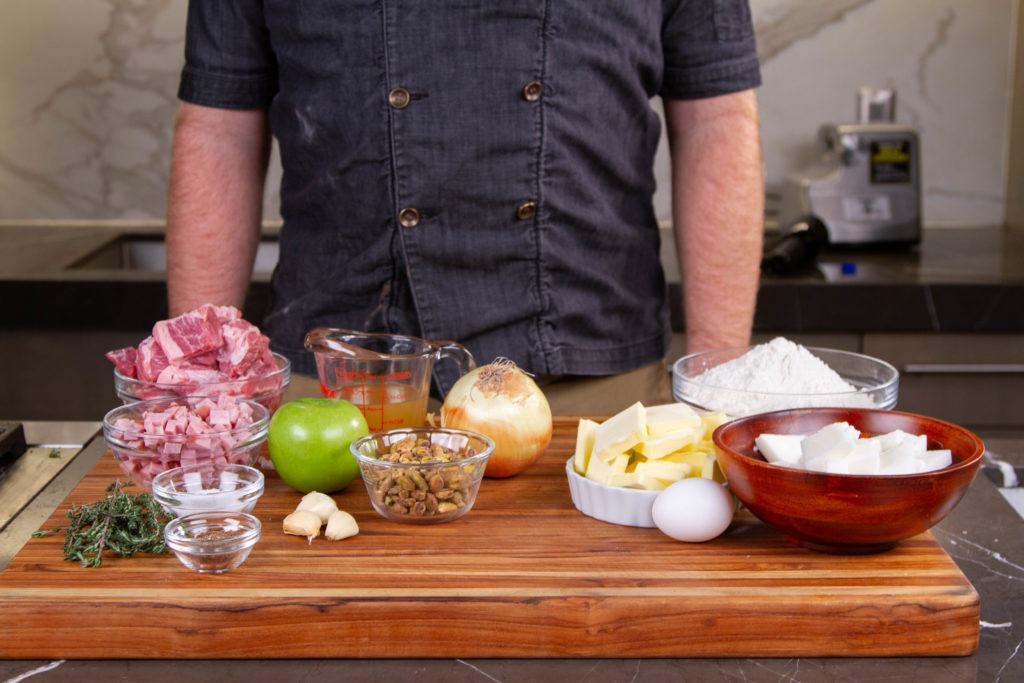
Instructions
Make the pastry dough
- Combine the flour, butter, and lard in a mixing bowl. Press the flour into the butter and lard between your fingers, creating a mealy texture.

- Crack the egg into a 1-cup measure and add cold water to make 1 cup. Whisk it to combine.
- Add the water/egg mixture to the flour mixture and mix to form a paste. It will be wetter than standard pie dough.

- Divide the dough in half and wrap as a disc. Refrigerate for at least 1 hour.

To make the filling
- Freeze the grinding apparatus for your meat grinder and bowls for at least a half hour.
- Sautee the onion, garlic, and apple in the butter over medium-high heat until it is translucent but not browned. Set aside to cool and once cool, refrigerate to chill.

- Combine the cold meat, salt, pepper, allspice, and thyme in a bowl.
- Grind the meat through the fine plate of a meat grinder into a bowl set in ice. (If using pre-ground pork, just combine the seasonings with the pork.)

- Add the chilled onion/apple mixture and mix by hand or
in a mixer until the meat becomes sticky and sort of fibrous looking.
- Add the cold chicken stock and mix to incorporate. (If using, mix in the ham and/or pistachios.) Cover and refrigerate.

To make the pie
- Preheat an oven to 425°F(220°C).
- Flour a work surface and roll out half the dough into a 12-inch circle. (It should be about 1/8” thick.)
- Transfer the dough circle to a baking sheet.

- Shape the meat mixture into a 5-inch disk that is about 2-3 inches thick in the center of the dough circle.
- Lift the edges of the dough circle to partially wrap the meat in
dough . The dough will not fully cover the meat.

- Roll out the second half of the dough until 1/8” thick.
- Cut a 6-inch circle from the dough. Cut a 2-inch circle from its center. Save the extra dough for another purpose.
- Prepare the eggwash by whisking together all the ingredients.
- Use a pastry brush to brush one side of the small dough circle with eggwash.

- Place the eggy side of the circle down on top of the meat/pastry. Crimp the edges to connect the ‘lid’ to the body of the pie.
- Brush the rest of the pie with eggwash, including the top.
- Smooth the sides of the pie, evening out the creases with your hands. The eggwash will allow you to slide your hands over the pie much l
ike a potter working with clay.
- Insert the probe from a ChefAlarm into the center of the pie through its steam vent. Set the high alarm for 150°F (65°C).

- Bake the pie in the oven for 15-20 minutes at 425°F (220°C), then turn down the oven to 325°F (160°C). You can use theChefAlarm’s built-in timer to time the first step.

- When the alarm sounds on your ChefAlarm, verify the temperature with your Thermapen®.
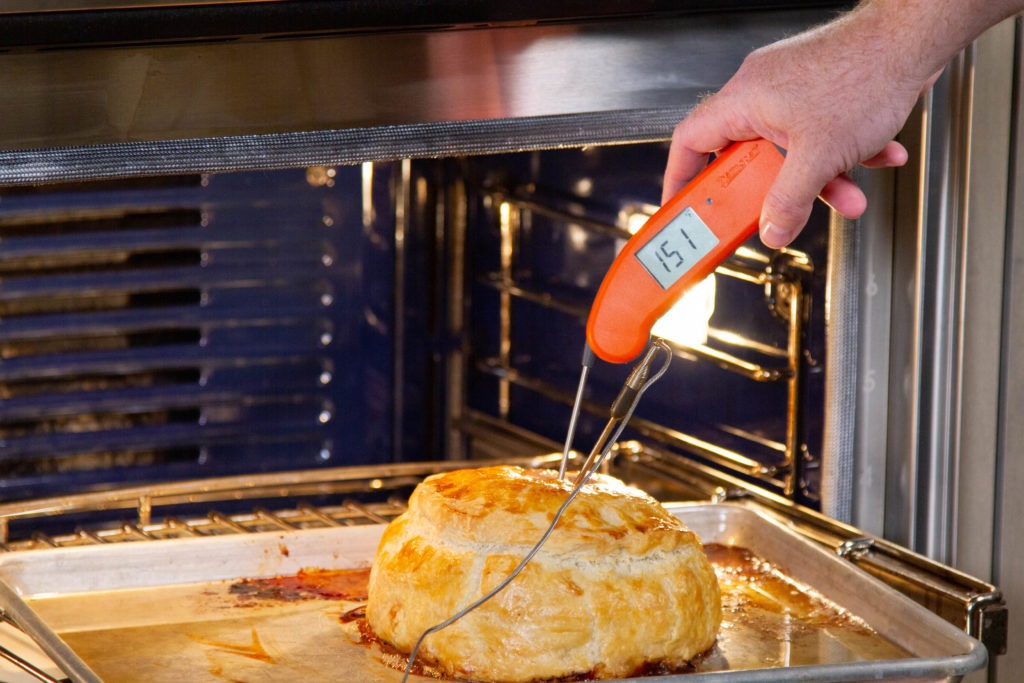
- Remove the pie from the oven and allow to cool on the counter. If there is excess liquid pooled in the top of the pie, you can spoon some of it out for a better presentation.
- Serve, or cool completely and serve chilled.
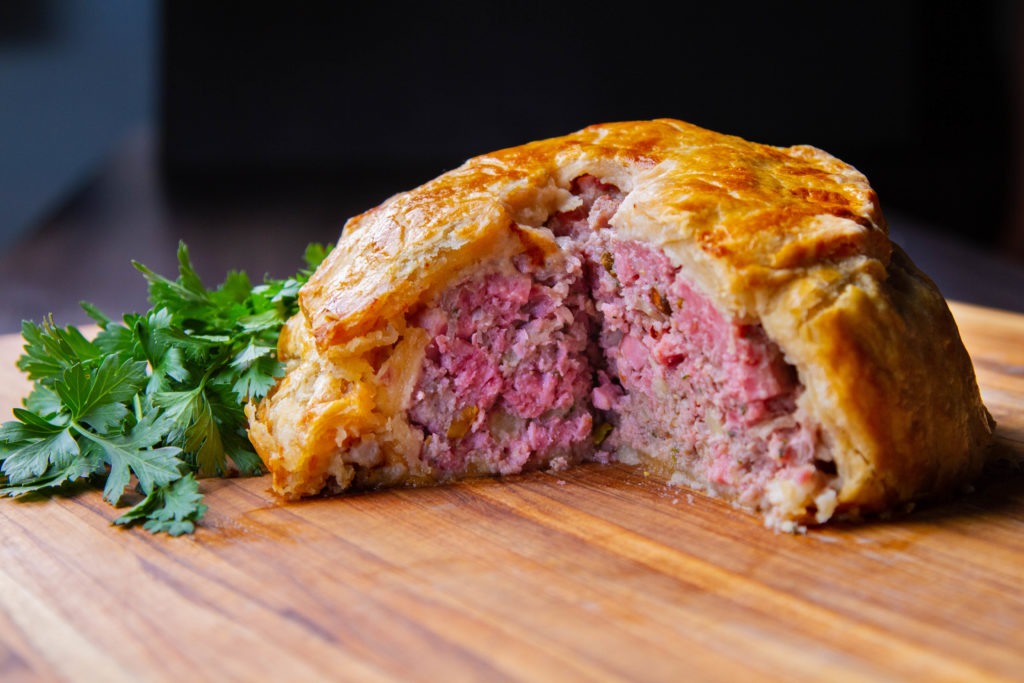
A pork pie is a hearty, savory dish to help you abide the dark winter months, and with the added help of fast and accurate thermometers like the Thermapen® and the ChefAlarm, your success at cooking one is almost assured. So roll out the Dickens and some flaky crust and enjoy this rich treat this holiday season!
Shop now for products used in this post:


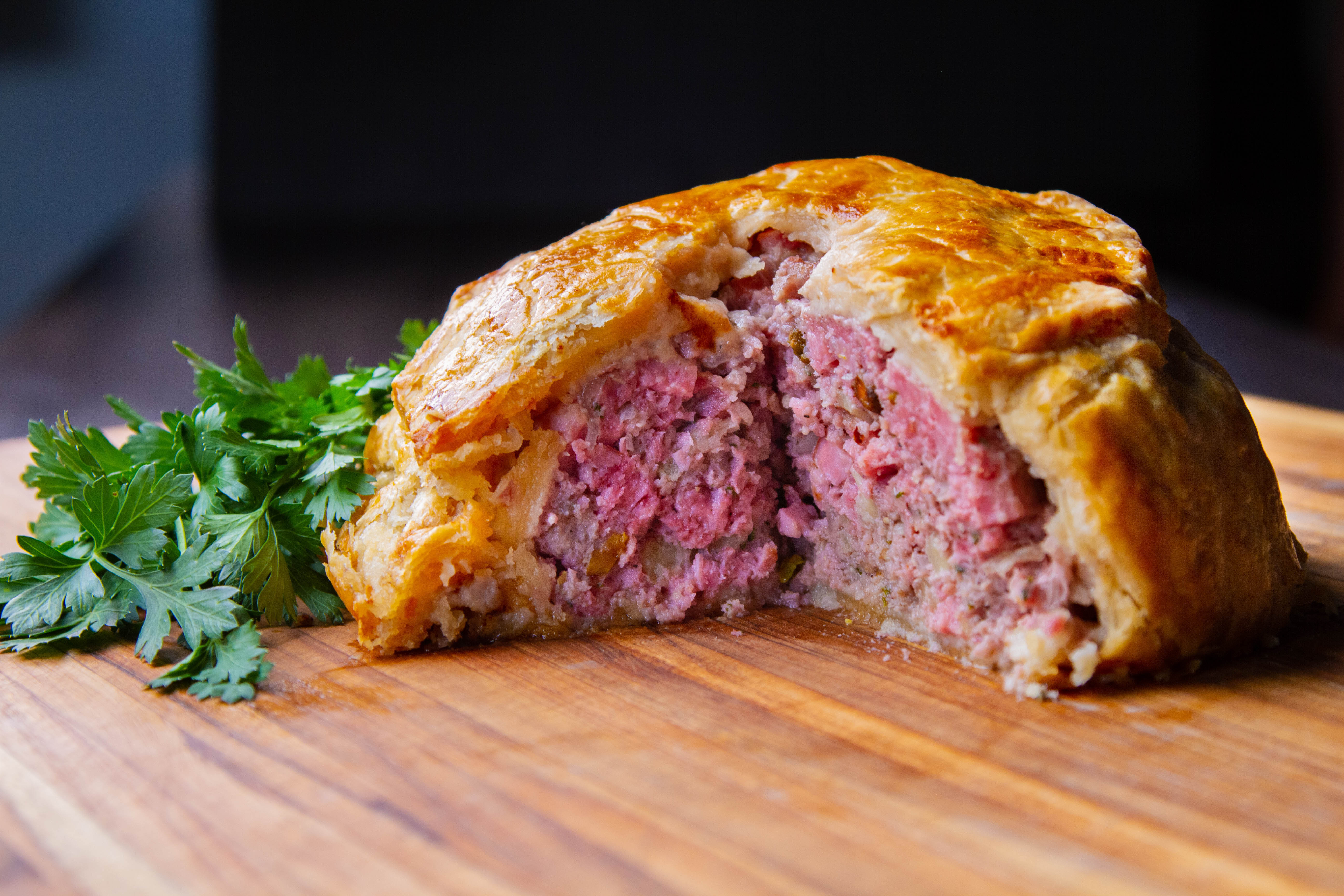
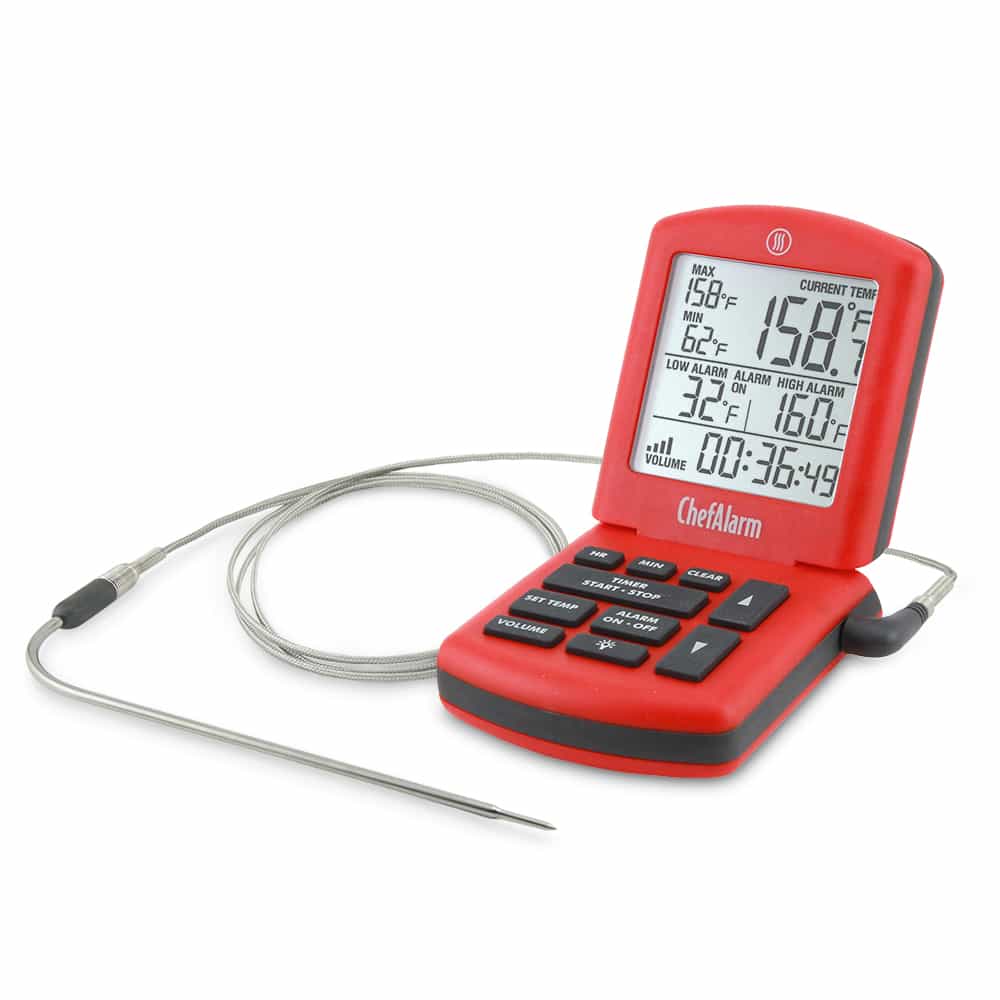
This is absolute NONSENSE. Utter twaddle…’in Yorkshire they are always eaten piping hot’
Well, I’ve lived in Yorkshire for over half a century and NOT ONCE have I ever seen, heard or know of anyone ever eating a pork pie hot. Where this drivel domes from I have no idea but it’s plainly ludicrous.
When I was doing my research on this post, I ran into one or two sources that said they are eaten hot in Yorkshire. I have edited it to remove that reference, in deference to ACTUAL lived experience! Thanks for the correction!
Hi, Pork Pie,
Just curious, as a fellow Yorkshireman, what on earth do you eat on bonfire night? Cold pie and peas? You’ve never bobbed into the butchers on the way to work and got a fresh pork pie that’s still hot? You’ve never had a meal deal from Tesco’s, the international supermarket chain, where the pies are stored in the hot cabinet with the sausage rolls and pasties? “NOT ONCE have I ever seen, heard or know of anyone ever eating a pork pie hot.” Absolute codswallop. You, with your fifty plus years in God’s Own County, the largest historic county, so large it had to be quartered to be manageable, can say without a doubt that nobody you know, in this vast swath of land, has eaten a warm pork pie? You are the one who is spouting drivel. I don’t want to sound racist but your comment has got “Leeds” written all over it, the least Yorkshire place in Yorkshire. Next you’ll say Jellied Eels are a Yorkshire delicacy. However, my distaste for Pork Pie aside, I do have a major problem with this recipe but the temperature of which the pie is consumed is largely irrelevant. You have missed the vital final step of a true pork pie:- the jelly. Once your pie is cooked, the hole in the top is for inserting the jellied stock (otherwise we’d just put slices in the pie top as usual). The fill hole is so the hot jelly can be piped in and left to set. Judging from the photo of your pie there wasn’t enough fat content in your meat filling. With the right fat content you get an element of shrinkage to the meat and the space that’s left behind is filled with a deliciously savoury jelly.
Frumptarn JB
P.s Martin, wonderful article (aside from you missed the jelly!!) consider me your third source that says pork pies are eaten hot in Yorkshire and ignore this negative nancy.
Actually we in Hartlepool eat pork pies hot from the oven from a local butchers
That sounds delicious!
In Yorkshire. pork pies are frequently eaten hot and are served with mushy peas and mint sauce, a favourite on bonfire night.
I would LOVE some mushy peas with this!
I am also a Yorkshireman and have never seen anyone in Yorkshire eat a hot pork pie. Also I would always make hot water pastry by combining lard and milk and water and bringing to a boil before adding to the flour. The pastry dough is then allowed to autolyse for an hour on the counter wrapped in plastic before being rolled out for base and lid of individual pies baked in a muffin tin. And the piece de resistance of a pork pie is filling the interstices with aspic once the pie has cooled!
Well when I was a child I used to go into Bradford market to the pie and peas shop where you used to get hot pork pie peas mint sauce and a plastic cup of tizer so I am sorry I very much beg to differ and I am a born and bred Yorkshire lass
warm small pork pie and peas is de riguer in Yorkshire with mint, brown sauce and thinnly sliced onions
The large”stand “pies are eaten cold
Nah, just wrong.
Pork pie needs a good hot water crust none of this light weight pastry.
Hand raised pork pies, with a proper porky filling.
Salt pepper, sage and fatty pork shoulder small chopped.
It should be a man’s pie with texture not minced to death so that granny can eat it without her teeth in.😁
Pork pies can be eaten hot or cold, in Derbyshire where I come from if you visit Chatsworth house you could get a fantastic hot pork pie or a cold one but hot is yummmy.